
Organic reaction mechanisms. 1998 / 15
.pdf
Organic Reaction Mechanisms - 1998: An Annual Survey Covering the Literature Dated December 1997 to November 1998. Edited by A. C. Knipe and W. E. Watts Copyright ∂ 2003 John Wiley & Sons, Ltd.
ISBN: 0-471-49017-2
CHAPTER 15 |
|
Molecular Rearrangements |
|
A. W. MURRAY |
|
Department of Chemistry, University of Dundee |
|
Aromatic Rearrangements . . . . . . . . . . . . . . . . . . . . . . . . . . . . . . . . . . . . . |
487 |
Benzene Derivatives . . . . . . . . . . . . . . . . . . . . . . . . . . . . . . . . . . . . . . . . |
487 |
Heterocyclic Derivatives . . . . . . . . . . . . . . . . . . . . . . . . . . . . . . . . . . . . . |
499 |
Sigmatropic Rearrangements . . . . . . . . . . . . . . . . . . . . . . . . . . . . . . . . . . . |
511 |
[3,3]-Migrations . . . . . . . . . . . . . . . . . . . . . . . . . . . . . . . . . . . . . . . . . . . |
511 |
Claisen and related rearrangements . . . . . . . . . . . . . . . . . . . . . . . . . . . . |
511 |
Cope and related rearrangements . . . . . . . . . . . . . . . . . . . . . . . . . . . . . . |
519 |
[2,3]-Migrations . . . . . . . . . . . . . . . . . . . . . . . . . . . . . . . . . . . . . . . . . . . |
525 |
Miscellaneous . . . . . . . . . . . . . . . . . . . . . . . . . . . . . . . . . . . . . . . . . . . . |
531 |
Electrocyclic Reactions . . . . . . . . . . . . . . . . . . . . . . . . . . . . . . . . . . . . . . . |
536 |
Anionic Rearrangements . . . . . . . . . . . . . . . . . . . . . . . . . . . . . . . . . . . . . . |
544 |
Cationic and Related Rearrangements . . . . . . . . . . . . . . . . . . . . . . . . . . . . |
553 |
Rearrangements in Natural-product Systems . . . . . . . . . . . . . . . . . . . . . . . . |
570 |
Rearrangements Involving Electron-deficient Heteroatoms . . . . . . . . . . . . . . |
577 |
Rearrangements Involving Organometallic Compounds . . . . . . . . . . . . . . . . |
581 |
Rearrangements Involving Ring Opening . . . . . . . . . . . . . . . . . . . . . . . . . . |
588 |
Isomerizations . . . . . . . . . . . . . . . . . . . . . . . . . . . . . . . . . . . . . . . . . . . . . |
599 |
Tautomerism . . . . . . . . . . . . . . . . . . . . . . . . . . . . . . . . . . . . . . . . . . . . . |
599 |
References . . . . . . . . . . . . . . . . . . . . . . . . . . . . . . . . . . . . . . . . . . . . . . . . |
603 |
Aromatic Rearrangements
Benzene Derivatives
The thermodynamic stabilities of phenonium ions have been determined1 based on bromide-transfer equilibria in the gas phase and, depending on the substituents, the bridged species (1) has been proposed2 as an intermediate or transition state on the potential-energy surface for the 1,2-aryl rearrangement of triarylvinyl cations (see Scheme 1). Phenonium ion (3) has been presented3 as an intermediate to account for the fact that lactonization of methyl 4-aryl-5-tosyloxy hexanoate (2) produces γ -lactone (4) selectively under thermodynamic conditions, but affords δ-lactone (5) preferentially under kinetic conditions. It has been shown that anodic oxidation of trans-stilbene in alcohols in the presence of KF or Bu4NBF4 is accompanied by its electro-oxidative rearrangement into diphenylacetaldehyde acetals. The mechanism outlined in Scheme 2 has been proposed4 for the transformation.
487
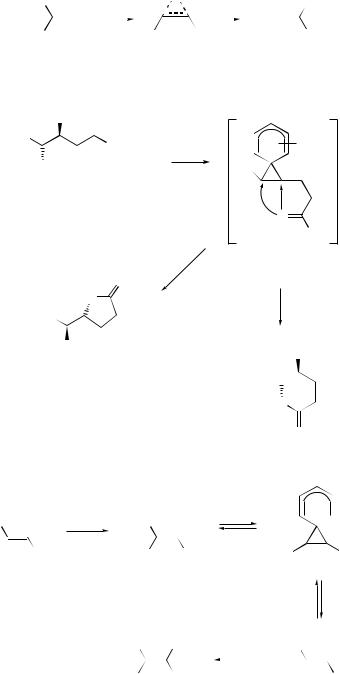
488 |
Organic Reaction Mechanisms 1998 |
Ar |
|
|
|
|
|
|
Ar |
|
|
|
|
Ar |
+ |
|
|
|
+ |
+ |
|||||||
|
Ar |
|
|
|
||||||||
Ar |
|
|
|
|
Ar |
Ar |
|
Ar |
|
|
Ar |
|
|
|
|
|
|||||||||
|
|
|
|
|||||||||
|
|
|
|
|
||||||||
|
|
|
|
|
|
|
|
|
||||
|
|
|
|
|
|
|
(1) |
|
|
|
|
|
SCHEME 1
|
Ar |
|
|
|
|
|
|
Me |
CO2Me |
|
|
+ |
R |
|
|
70 °C |
|
|||
|
|
|
|
|
||
|
OTs |
|
Me |
|
|
|
|
|
|
|
|
||
|
(2) |
|
|
|
b |
|
|
|
|
|
a |
|
|
|
|
|
|
O |
|
|
|
|
|
|
|
|
|
|
|
|
|
|
|
OMe |
|
|
|
b |
|
(3) |
|
|
|
O |
|
|
|
|
|
O |
|
|
|
a |
|
|
|
|
|
|
|
|
|
Me |
|
|
|
|
|
|
Ar |
|
|
|
|
Ar |
|
(4) |
|
|
|
|
|
|
|
|
Me |
|
|
|
|
|
|
|
|
|
|
|
|
|
|
|
O |
|
|
|
|
|
|
|
O |
|
|
|
|
|
(5) |
|
|
|
|
|
|
|
+ |
Ph |
−ε |
Ph |
+ |
|
|
|
|
MeOH |
|
|
|
|
|
|
|
|
|
|
|
|
|
−ε |
MeO |
Ph |
|
Ph |
OMe |
|
Ph |
|
Ph |
OMe |
Ph |
|
||
|
|
MeOH |
|
+ |
|
Ph |
OMe |
Ph |
|||
OMe |
|||||
|
SCHEME 2 |
|
|
||
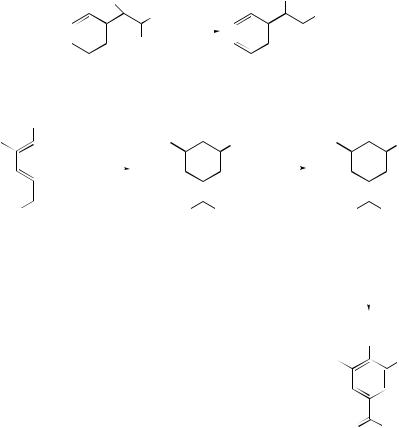
15 Molecular Rearrangements |
489 |
The AgBF4-catalysed phenyl rearrangement of the dimethyl acetal of 2-chloro- propiophenone (6) has been found5 to proceed with inversion of stereochemistry at the reaction centre to give 2-phenylpropionic acid (7) with high stereoselectivity. This result suggests an Ag+-aided, phenyl-assisted, intramolecular SN2 mechanism for the rearrangement. 3,5-Di-t -butyl-4-hydroxybenzaldehyde acetals have been observed to rearrange to various esters when oxidized with potassium ferricyanide in alkaline medium. The authors6 suggested that the initial step in the transformation involves formation of quinone methide (8). Addition of water and subsequent elimination of alcohol would lead to the formation of ester (9). A free-radical mechanism involving initial homolysis of different bonds in the acetal molecules has been postulated7 to explain the plethora of products obtained on the thermal rearrangement of aromatic acetal and thioacetal derivatives. On the other hand, a carbocation mechanism (see Scheme 3) has been proposed8 to account for the fact that aromatic acetals react with iodobenzene dichloride to give esters and aldehydes depending on the solvent.
|
|
MeO |
OMe |
|
|
|
|
|
Me |
|
|
|
|
|
|
|
|
||||||||||
|
|
|
|
|
|
|
|
|
|
|
|
|
|
|
|
|
|
|
|||||||||
|
|
|
|
|
|
|
|
Me |
|
|
|
|
|
|
|
OMe |
|
|
|
|
|
|
|
|
|||
|
|
|
|
|
|
|
|
|
|
|
|
|
|
|
|
|
|
|
|
|
|
|
|
|
|
|
|
|
|
|
|
|
|
|
|
|
|
|
|
|
|
|
|
|
|
|
|
|
|
|
|
|
|
|
|
|
|
|
|
|
|
|
|
|
|
|
|
|
|
|
|
|
|
|
|
|
|
|
|
|
|
|
|
|
|
|
|
|
|
Cl |
|
|
|
|
|
O |
|
|
|
|
|
|
|
|
|||||||
|
|
|
|
|
|
|
|
|
|
|
|
|
|
|
|
|
|
|
|||||||||
|
(6) |
|
|
|
|
|
|
|
|
|
|
(7) |
|
|
|
|
|
|
|
|
|
|
|
||||
|
OH |
|
|
|
|
|
|
|
|
|
|
|
|
||||||||||||||
|
|
|
|
|
|
O |
|
|
|
|
O |
||||||||||||||||
But |
|
But |
|
But |
|
|
|
|
But |
|
|
But |
|
|
|
|
|
|
But |
||||||||
|
|
|
|
|
|
|
|
|
|||||||||||||||||||
|
|
|
|
|
|
|
|
|
|
|
|
|
|
|
|
H2O |
|
|
|
|
|
|
|
|
|
|
|
RO |
OR |
|
|
RO |
|
|
|
OR |
|
|
RO |
|
|
|
|
|
OR |
||||||||||
|
|
|
|
|
|
|
|
|
|
|
|
||||||||||||||||
|
|
|
|
|
|
|
|
|
|
|
|
||||||||||||||||
|
|
|
|
|
|
|
|
|
|
|
|
|
|
|
|
|
|
|
|
OH |
|||||||
|
|
|
|
|
|
|
|
|
|
|
(8) |
|
|
|
|
|
|
|
|
|
|
|
|
|
|
||
|
|
|
|
|
|
|
|
|
|
|
|
|
|
|
|
|
|
|
|
|
|
|
|
|
|||
|
|
|
|
|
|
|
|
|
|
|
|
|
|
|
|
|
|
|
|
|
|
|
|
|
R′OH |
||
|
|
|
|
|
|
|
|
|
|
|
|
|
|
|
|
|
|
|
|
|
|
|
|
|
|||
|
|
|
|
|
|
|
|
|
|
|
|
|
|
|
|
|
|
|
|
|
|
|
|||||
|
|
|
|
|
|
|
|
|
|
|
|
|
|
|
|
|
|
|
|
OH |
|||||||
|
|
|
|
|
|
|
|
|
|
|
|
|
|
|
|
|
|
But |
|
|
|
|
|
|
But |
||
O OR
(9)
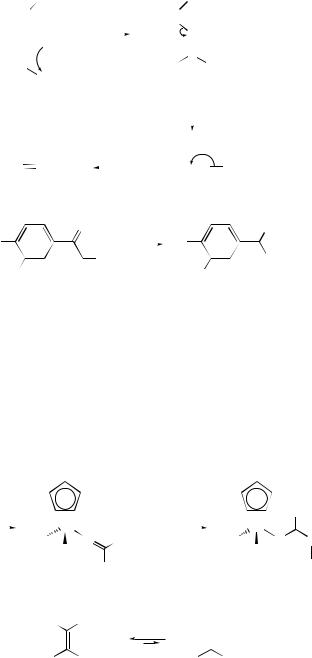
490 |
|
|
|
|
|
|
|
|
|
|
Organic Reaction Mechanisms 1998 |
|||||||
|
|
OR |
|
|
|
|
|
|
|
|
OR |
|
|
|
|
|||
C6H5CH |
|
|
|
|
|
|
|
|
C6H5CH |
|
|
|
|
|||||
|
|
|
|
|
|
|
+ |
|
+ |
Cl− |
||||||||
|
|
OR |
|
|
|
|
|
|
|
|
OR |
|||||||
|
|
|
|
|
|
|
|
|
|
|||||||||
|
|
•• |
|
|
|
|
|
|
|
|
|
|
|
|
|
|
|
|
|
|
|
|
|
|
|
|
|
|
|
|
|
|
|
|
|
||
|
|
|
Cl |
|
|
|
|
|
|
|
I |
|
|
|
|
|||
Cl |
|
|
|
|
|
|
|
Cl |
Ph |
|
||||||||
|
|
I |
|
|
|
|
|
|
|
|
|
|
|
|
|
|
|
|
|
|
|
|
|
|
|
|
|
|
|
|
|
|
|
|
|
|
|
|
|
|
Ph |
|
|
|
|
|
|
|
|
|
|
|
|
|
|
|
C6H5CH |
O + |
RCl |
|
Cl− |
+ |
|
|
|
|
R |
+ PhI(Cl)(OR) |
|||||||
|
|
|
|
|
||||||||||||||
|
|
|
|
|
C6H5CH |
|
|
O |
|
|||||||||
|
|
|
|
|
|
|
||||||||||||
|
|
|
|
|
|
|
SCHEME 3 |
|
|
|
|
|||||||
|
|
|
|
O |
|
|
|
|
|
|
|
|
|
|
|
|
|
Me |
R |
|
|
|
Me |
|
|
|
|
R |
|
|
|
CO2Me |
|||||
|
|
|
|
|
|
|
|
|
|
|||||||||
|
|
|
|
|
|
|
|
|
|
|
|
|
|
|
|
|||
F |
|
|
|
|
|
|
|
|
|
|
F |
|
|
|
||||
|
|
|
|
|
|
|
|
|
|
|
|
|
|
|
|
|||
|
|
(10) |
|
|
|
|
|
|
|
|
|
|
|
(11) |
||||
R = cyclohexyl |
|
|
|
|
|
|
|
|
|
|
|
|
|
|
||||
It has been shown9 that the lead tetraacetate-mediated 1,2-aryl shift of various meta- substituted p-cyclohexyl aryl ketones, e.g. (10), results in excellent yields of the corresponding rearranged esters (11). A unique reaction, providing 3-hydroxy-2- arylacrylic acid ethyl esters (14), has been observed10 between aryl aldehydes and ethyl diazoacetate in the presence of the iron Lewis acid [η5 − (C5H5)Fe(CO)2(THF)BF4]. It appears that the enol esters are formed by an unusual 1,2-aryl shift from a possible intermediate (13), which in turn is formed from the reaction of the iron aldehyde complex (12) with ethyl diazoacetate (see Scheme 4).
|
|
|
|
|
|
N2CHCO2Et |
|
|
|
H |
|
|
|
|
|
|
|
|
|
Ar |
|
ArCHO |
|
OC |
Fe + |
OC |
Fe |
|||||
|
|
|
|
|||||||
|
|
|
O |
H |
|
O |
CHCO2Et |
|||
|
|
|
CO |
Ar |
|
CO |
N2+ |
|||
|
|
|
|
|
|
|
|
|||
|
|
|
(12) |
|
|
|
(13) |
|
||
HOH
CHO
Ar |
CO2Et |
Ar |
CO2Et |
(14)
SCHEME 4
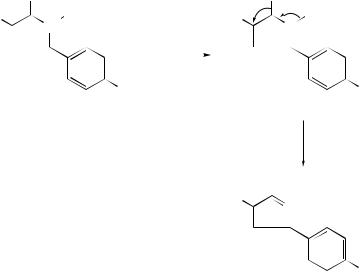
15 Molecular Rearrangements |
491 |
The rearrangement reaction of a variety of alkyl phenyl ethers over a dealuminated HY zeolite has been shown to involve both intramolecular and intermolecular processes to afford phenol, (alkoxyalkyl)benzenes and alkylphenols as the main products.11 o-Benzylphenol has been obtained12 as the exclusive product in the rearrangement of benzyl phenyl ether in the presence of montmorillonite. The mechanism for a novel zeolite β-catalysed rearrangement of alkoxybenzyl allyl ethers to aldehydes and ketones has been investigated by the use of cross-over reactions and deuterium labelling. The reaction was found to be mainly intramolecular and has been described13 as a nucleophilic attack of the double bond on the electrophilic benzylic carbon of the ether–Lewis acid complex, followed by a 1,2-hydride (or alkyl) migration (see Scheme 5). The best conditions for this rearrangement have been examined,14 and preliminary results have indicated that there is a dependence between the size of the substrate and the pore size of the zeolite. Several allylic p-methoxybenzyl ethers have been rearranged under these conditions to afford a variety of 4-arylbutanals or 5-arylpentan-2-ones, depending on the substituent pattern of the allylic moiety.15 The Lewis acid-catalysed diastereoselective rearrangement of methyl 4,5-trans-4-aryldioxolan-5-yl acetates (15) has been used16 to provide a convenient route to substituted isochromane-γ -lactones (16) (see Scheme 6).
An unusual [1,3]-rearrangement of aryl 2-halocyclohexenylmethyl ethers promoted by trifluoroacetic acid has been observed.17 Products due to a Claisen rearrangement were not formed and the proposed pathway for the process is outlined in Scheme 7. It has been shown18 that AlCl3-mediated decomposition of N -phenoxybenzamide
|
|
H |
|
|
H |
||
R |
+ L− |
|
R |
L− |
|||
|
|
O |
+ |
O |
|||
|
|
||||||
|
|
|
OMe |
|
|
|
OMe |
|
|
|
|
|
|
||
|
|
|
|
|
|
||
|
|
|
|
|
|
||
|
|
|
|
|
|
||
R
O
OMe
SCHEME 5
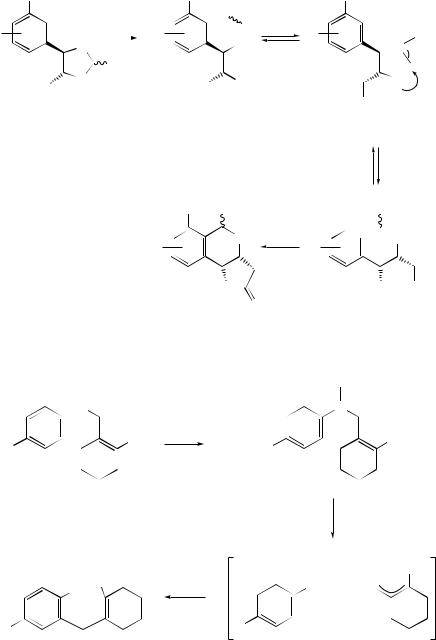
492 |
Organic Reaction Mechanisms 1998 |
OMe |
|
OMe |
||||||
|
|
|
|
|
|
Me |
||
|
|
|
|
|
|
|
|
|
R |
|
|
|
R |
|
|
|
|
|
|
O |
|
|
|
O+ |
||
|
|
|
|
|
|
|
|
|
|
|
|
Me |
|||||
|
|
O |
|
|
|
OX |
||
|
|
|
|
|
|
|||
|
|
|
|
|
|
|
|
|
|
CO2Me |
|
CO2Me |
|||||
(15) |
|
X = TiCl4− |
||||||
OMe Me
O
R
O
O
(16)
SCHEME 6
O
X TFA
R 
 R
R
X
OH
R |
R |
R
R
OH
OMe
+ X
 O
O
 Me O
Me O
••
CO2Me
OMe Me
 O+
O+
OX CO2Me
H
O+
X
X
CH2 +
+
SCHEME 7
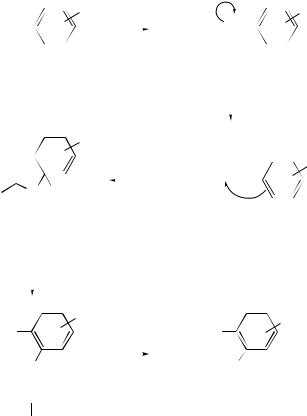
15 Molecular Rearrangements |
|
|
|
|
|
|
|
|
|
|
|
|
493 |
||||||||||||||
|
|
|
|
|
|
|
|
|
R |
|
|
|
+ |
|
|
|
|
|
|
R |
|||||||
|
|
|
|
|
|
|
|
|
|
AlCl3 |
|
|
|
|
|
|
|
|
|
|
|||||||
PhCONHO |
|
|
|
|
|
|
|
|
|
|
PhCONH O |
|
|
|
|||||||||||||
|
|
|
|
|
|
|
|
|
|
|
|
|
|||||||||||||||
|
|
|
|
|
|
|
|
|
|
|
|
|
|
|
|
|
− |
|
|
|
|
|
|
|
|
|
|
(17) |
|
|
|
|
|
|
|
|
|
|
|
|
AlCl3 |
|
|
|
|||||||||||
|
|
|
|
|
|
|
|
|
|
|
|
|
|
||||||||||||||
|
|
|
|
|
|
|
|
|
|
|
|
|
|
|
|
|
|
|
|
−HCl |
|
|
|
||||
|
|
|
|
|
|
|
|
|
|
|
|
|
|
|
|
|
|
|
|
|
|
|
|||||
− |
|
|
|
|
|
|
R |
O |
|
|
|
|
− |
|
|
|
|||||||||||
|
|
|
|
|
|
|
|
|
|
|
|
|
|||||||||||||||
|
|
|
|
|
|
|
|
|
|
|
|
|
|||||||||||||||
|
|
|
|
|
|
|
|
|
|
|
|
|
|
|
|
|
|||||||||||
Cl3AlO |
+ |
|
|
|
|
|
|
|
|
|
|
|
|
|
|
|
AlCl3 |
|
|
R |
|||||||
|
|
|
|
|
|
|
|
|
|
||||||||||||||||||
|
O |
|
|
|
|
|
|
|
|
|
|
|
|
|
|
|
|
|
|
|
|
|
|
|
|
||
|
|
|
|
|
|
|
|
|
|
|
Ph |
N+ O |
|
|
|
||||||||||||
|
|
|
|
|
|
|
|
|
|
|
|
|
|
|
|
||||||||||||
Ph |
|
N H |
|
|
|
||||||||||||||||||||||
|
|
|
|
|
|
|
|
|
|
|
|
|
|
|
|
||||||||||||
|
|
|
|
|
|
|
|
|
|
|
|
|
|
|
|
|
|
|
|
|
|
|
|
|
|
|
|
|
|
|
|
|
|
|
|
|
|
|
|
|
|
|
|
Al |
|
|
|
||||||||
|
|
|
|
|
|
|
|
|
|
|
|
|
|
|
|
|
|
|
|||||||||
|
|
|
|
Al |
|
|
|
|
|
|
|
|
|
|
|
|
|
|
|
||||||||
|
|
|
|
|
|
|
|
|
|
|
|
|
|
|
|
|
|
|
|||||||||
|
|
|
|
|
|
|
|
|
|
|
|
|
|
|
|
|
|
|
|
|
|
|
|
|
|
|
|
|
|
|
|
|
|
|
|
|
|
|
|
|
|
|
|
|
|
||||||||||
−HCl |
|
|
|
|
|
|
|
|
|
|
|
|
|
|
|
|
|
|
|||||||||
Cl2AlO |
|
|
|
|
|
|
R |
|
|
|
|
|
|
|
|
|
|
|
|
R |
|||||||
|
|
|
|
|
|
|
|
|
|
|
|
|
|
|
|
|
|
||||||||||
|
|
|
|
HO |
|||||||||||||||||||||||
|
|
|
|
|
|
|
|
|
|
|
|
||||||||||||||||
|
|
|
|
|
|
|
|
H2O |
|
|
|
|
|
||||||||||||||
|
|
|
|
|
|
|
|
|
|
|
|
|
|
|
|
|
|
|
|
|
|
|
|
|
|
||
PhCON |
|
PhCONH |
|
|
|
||||||||||||||||||||||
|
|
|
|
|
|
|
|
|
|
|
|
|
|
|
|
|
|
|
|
|
|
|
|
|
|||
|
|
|
Al |
|
|
|
|
|
|
|
|
|
|
|
|
|
|
|
|||||||||
|
|
|
|
|
|
|
|
|
|
|
|
|
|
|
|
|
|
||||||||||
SCHEME 8
derivatives (17) leads mainly to regioselective intramolecular migration of the benzamido group from oxygen to the ortho position of the phenyl group as shown in Scheme 8. Zeolite catalysts have been evaluated19 for the Fries rearrangement of acetanilide to the corresponding aminoacetophenones, and the selectivity of the Fries rearrangement over various silica composite catalysts has been compared.20 Alumina in methanesulfonic acid has been used as an efficient reagent for the Fries rearrangement of phenolic esters.21 A novel method of acylating 2(3H )-benzoxazolone and 2(3H )-benzothiazolone at the 6-position has been described.22 It consists of a Frieslike transposition of the acyl group from the nitrogen atom to the 6-position (see Scheme 9). The photo-Fries rearrangement of N -acetyl- and N -benzoyl-carbazoles has been studied.23 The anions resulting from the treatment of monoor dicarbamates of 1,1 -bi-2-naphthols with But Li/TMEDA have been found24 to undergo anionic Fries rearrangements to yield monoand di-(3-alkyl)- or -(3-amido)-substituted 2, 2 - binaphthols. The Fries migration of various calix(n)arene esters (n = 4, 6, 8) under the influence of different solvents and Lewis acid catalysts has been examined,25

494 |
|
|
|
|
|
|
|
Organic Reaction Mechanisms 1998 |
||||||||
|
|
|
|
|
O |
R |
|
|
|
|
|
|
||||
|
|
|
|
|
|
|
|
|
|
|
|
|
|
|||
|
|
H |
|
|
|
N |
|
|
|
|
|
H |
|
|
|
|
|
|
N |
|
|
|
|
|
|
|
|
N |
|
|
|
||
|
|
|
|
RCOCl |
|
|
AlCl3 |
O |
|
|
|
|
|
|||
|
|
|
|
|
|
|
|
|
|
|
||||||
O |
|
|
|
|
O |
|
X |
|
|
|
|
X |
|
|
R |
|
|
|
|
|
|
|
|
|
|
|
|
||||||
|
|
|
|
|
|
|
|
|
|
|||||||
|
|
X |
|
|
|
|
|
|
|
|
|
|
||||
|
|
|
|
|
|
|
|
|
|
|
|
|
||||
|
|
|
|
|
|
|
|
|
|
|
|
|
||||
|
|
|
|
|
|
|
|
|
|
|
|
|
|
|
|
|
O
SCHEME 9
and an unusual benzoyl rearrangement has been observed26 during the synthesis of asymmetrically substituted calix(4)arenes.
A new synthetic protocol consisting of sequential directed ortho metallation, crosscoupling and a carbamoyl Baker–Venkataraman rearrangement has been applied27,28 to an efficient construction of coumarins (see Scheme 10). The formation of o-nitrosobenzaldehyde during the hydrolysis of o-nitrobenzyl tosylate in aqueous acetonitrile has been presented29 as a strong indication that the nitro group participates in the departure of the tosylate group as shown in Scheme 11.
|
|
|
O |
O |
Cl |
|
R′ |
|
|
|
|
O |
|
O |
|
|||||
|
|
|
|
|
|
|
|
|
|
|
|
|
|
NEt2 |
||||||
|
|
|
|
|
|
|
|
|
|
|
|
|
||||||||
R |
|
|
|
|
|
|
|
|
R |
|
|
|
|
|
|
|
− |
|||
|
|
|
|
|
O |
|
|
|
|
|
|
|
||||||||
|
|
|
NEt2 |
|
|
|
|
|
|
|
|
R′ |
||||||||
|
|
|
ZnCl |
|
Pd(0) |
|
|
|
|
|
|
|
||||||||
|
|
|
|
|
|
|
||||||||||||||
|
|
|
|
|
|
|
|
|
|
|
|
|
|
|
|
|
|
|
|
|
|
|
|
|
|
|
|
|
|
|
|
|
|
O |
|
|
|
||||
O O
R
R′
OH
SCHEME 10
The α- and β-cyclodextrins have been found to accelerate the Smiles rearrangement of 4-nitrophenyl salicylate.30 The reaction of 2,4-dinitrobenzenesulfonamide with acyl chlorides in the presence of excess triethylamine has been found to produce the corresponding nitrile in good yield. Mechanistic studies have indicated31 that the reaction proceeds via a Smiles rearrangement of the initially formed N -(2,4- dinitrobenzenesulfonyl)amide to form the nitrile, 2,4-dinitrophenol, and sulfur dioxide (see Scheme 12). 1-Chloro-3-fluorophenothiazines have been prepared32 by Smiles rearrangement of 3-chloro-5-fluoro-2-formamido-2 -nitrophenyl sulfides in alcoholic
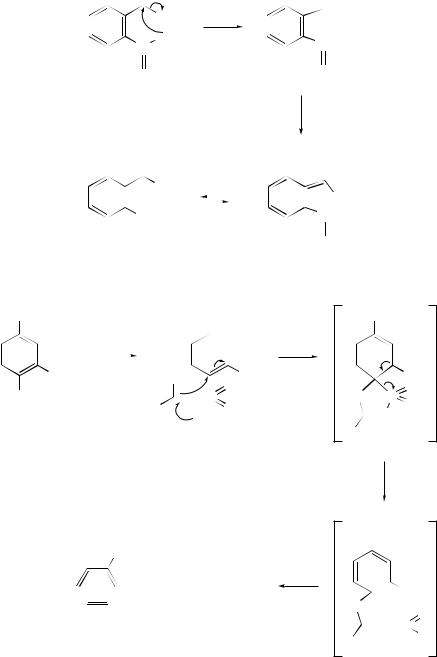
15 Molecular Rearrangements
OTs
+ O−
N
O
|
|
|
|
|
|
|
|
|
|
O |
|
|
|
|
|
|
|
|||
|
|
|
|
|
|
|
|
|
|
|
|
|
H |
|
|
|
|
|||
|
|
|
|
|
|
|
|
|
|
|
|
|
|
|
|
|
||||
|
|
|
|
|
|
|
|
|
|
|
|
|
||||||||
|
|
|
|
|
|
|
|
|
|
N |
|
O |
|
|
|
|
||||
|
|
|
|
|
|
|
|
|
|
|
|
|
|
|
||||||
|
|
|
|
|
|
|
|
|
|
|
|
|
|
|
||||||
|
|
|
|
|
|
|
|
|
|
|
|
|
|
|||||||
|
|
|
|
|
|
|
|
|
|
|
|
|
|
|||||||
|
|
|
|
|
|
|
|
|
|
|
|
|
|
|
SCHEME 11 |
|||||
|
|
|
|
NO2 |
|
|
|
NO2 |
||||||||||||
|
|
|
|
|
|
|
|
RCOCl |
|
|
|
|
|
|
|
|
||||
|
|
|
|
|
|
|
|
|||||||||||||
|
|
|
|
|
|
|
|
TEA |
|
|
|
|
|
|
|
|||||
|
|
|
|
|
|
|
|
|||||||||||||
|
|
|
|
|
|
|
NO2 |
O |
|
|
|
NO2 |
||||||||
O |
|
|
|
S |
|
O |
|
|
|
|
|
O |
||||||||
|
|
|
|
|
|
|
|
|
||||||||||||
|
|
|
|
|
S |
|||||||||||||||
|
|
|
|
|
|
|
||||||||||||||
|
|
|
|
|
|
|
||||||||||||||
|
|
|
|
|
|
|
|
|
|
|
|
|
R |
|
N |
|
|
O |
||
|
|
|
|
|
|
|
|
|
|
|
|
|
|
|
|
|||||
|
|
|
|
|
|
|
|
|
|
|
|
|
|
|
− |
|
|
|
|
|
|
|
|
|
|
NH2 |
|
|
|
|
|
|
|
||||||||
NO2
O2N
 O− + SO2 + RCN
O− + SO2 + RCN
495
+  O
O
N
O
−H+

 +
+  O
O
N
O−
|
|
NO2 |
|
|
|
|
|
− |
NO2 |
|
|
|
||
|
|
|||
|
|
|
|
|
O |
|
S |
O |
|
|
O |
|||
|
|
|
N |
|
|
|
|
|
|
|
|
|
|
|
|
|
|
|
|
R
NO2
NO2
O
− O
 N
N S
S
R O
O
SCHEME 12
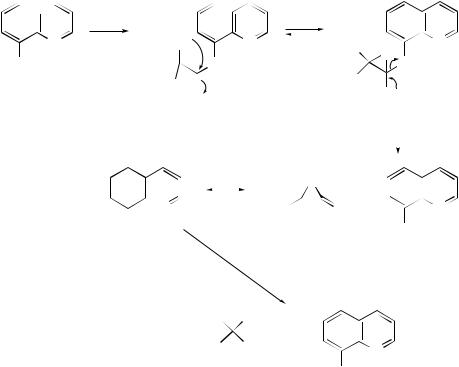
496 |
Organic Reaction Mechanisms 1998 |
potassium hydroxide solution, and 8-hydroxyquinoline (18) has been converted33 into 8-aminoquinoline (19) in a one-pot procedure involving alkylation with 2- bromo-2-methylpropionamide followed by Smiles rearrangement and hydrolysis (see Scheme 13). The reaction of benzenediazonium chloride with 3,4-diphenyl-1,2,4- triazol-5-yl-thiomethylene compounds (20) resulted in the formation of azo coupling products (21), which upon treatment with sodium ethoxide in ethanol have been found34 to yield thiohydrazonate esters (22) that rearrange in situ by a Smiles-type rearrangement to afford thiohydrazides (23).
The formation of 3,3-difluoro-3-arylpropanoates in good yields from the radicalinduced rearrangement of 3-bromo-3,3-difluoroalanine Schiff bases has been explained35 by postulating a radical ipso-substitution at the aromatic ring as shown in Scheme 14.
Montmorillonite K10 clay and its various cation-exchanged forms have been found to promote the formation of an unexpected product, p-nitrosodiphenylamine, from N -phenylhydroxylamine, rather than the typical Bamberger products.36 A Bamberger rearrangement has been shown to occur during the metabolism of 2,4,6-trinitrotoluene
N |
|
|
|
O− |
|
|
|
|
N |
|
Me |
|
|
N |
|
|
|
|
|
|
|
|
|
|
|
O |
|||
|
|
|
|
|
|
|
|
|
|
|
|
|||
OH |
|
|
Me |
|
|
NH |
|
|
|
NH |
||||
(18) |
|
|
|
Me |
|
|
|
|
|
|
Me |
O− |
||
|
|
|
|
|
|
|
|
|||||||
|
|
|
O |
|
|
|||||||||
|
|
|
|
|
|
|
||||||||
|
− |
|
|
|
|
|
|
|
|
|
|
|||
|
|
|
|
|
|
|
|
|
|
|
||||
|
|
|
|
|
|
|
|
|
|
|
||||
|
|
|
|
|
|
|
|
|
Me |
O |
+ |
|
|
|
|
|
|
|
|
|
|
|
|
|
|
||||
|
|
|
|
|
|
|
|
|
|
|
|
|
||
|
|
|
|
|
|
|
|
|
|
|
|
|||
|
|
|
|
N |
|
|
|
|
Me |
|
O |
|
|
N |
|
|
|
|
|||||||||||
|
|
|
|
|
|
|
|
|
|
|
−NH |
|||
|
NH |
|
|
|
|
|
|
|
||||||
Me OH
+
Me CO2H |
N |
NH2 (19)
SCHEME 13
